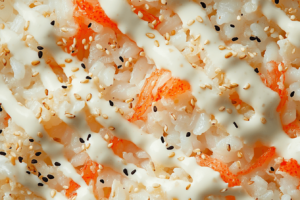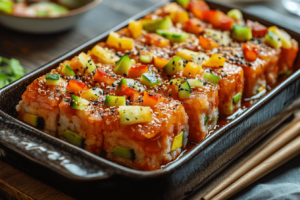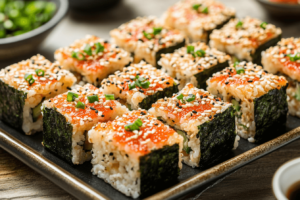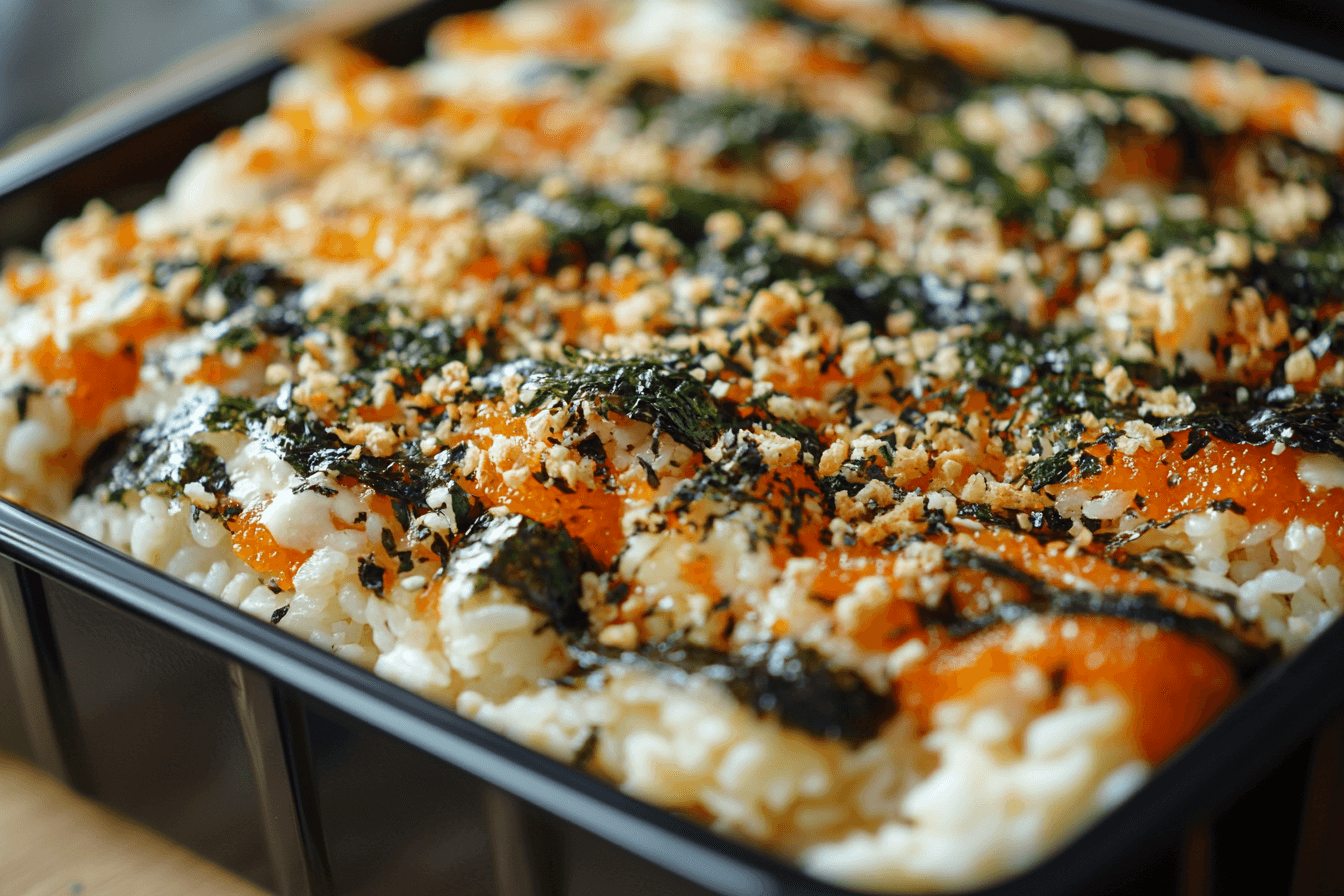Welcome to a fun and flavorful world of sushi bake! This dish has taken the culinary scene by storm because it offers a convenient way to enjoy the taste of a traditional sushi roll without the hassle of shaping individual pieces. Instead, you get a rich casserole-style meal that bursts with savory layers of rice, seafood, creamy sauces, and crunchy toppings. Fans of Japanese cuisine love this oven-baked sushi creation because it blends classic sushi flavors with the comfort of a homemade casserole.
Many people appreciate the ease of preparing a sushi bake recipe. You can make it in one pan and feed a crowd at a party or family gathering. Moreover, you can experiment with different fillings, sauces, and toppings to suit your preferences. Because it is so versatile, you can adapt this dish to accommodate dietary choices. Besides, you can even swap out ingredients to create an entirely new flavor profile. This makes it a top choice for food enthusiasts who desire variety.
In this article, you will learn how to craft your own sushi bake recipe. We will cover the best ingredients, helpful tips, and step-by-step instructions. You will also find creative ways to add more texture and taste to this popular dish. Furthermore, we will include a special section on serving suggestions, as well as a concise Frequently Asked Questions segment. By the end, you will be eager to gather your ingredients, preheat the oven, and experience this incredible fusion of sushi and casserole.
Why This Baked Sushi Casserole Is Worth Trying
A baked sushi casserole offers a unique twist on traditional sushi rolls. Although typical sushi features fresh fish, sticky rice, and nori sheets, a sushi bake recipe shifts the focus. Instead of rolling everything into small cylinders, you layer ingredients in a baking dish, top them with sauces and spices, and place the entire creation in the oven. This results in a warm, mouthwatering meal that is easy to slice and serve.
Moreover, a sushi bake is friendly for those who feel intimidated by rolling nori or handling raw fish. You can use cooked seafood, imitation crab, or even vegetables. That way, you keep the flavorful essence of sushi but reduce some of the effort. In addition, the oven-baking technique helps meld the flavors together, creating a rich, comforting taste.
Another major draw of this baked sushi dish is how simple it is to prepare. Because the baking dish holds everything, cleanup is minimal. In many cases, you can assemble the casserole ahead of time, then bake it when you are ready to eat. This flexibility saves you time and energy, especially if you are hosting a get-together or planning a casual family dinner.
Key Differences From Classic Sushi Rolls
- Temperature: Traditional sushi is served cold or at room temperature. On the other hand, a sushi bake goes into the oven, making it a warm and cozy dish that still retains classic sushi flavors.
- Presentation: Regular sushi comes in neat, bite-sized pieces, but a sushi bake recipe is served casserole-style. You can cut squares or scoop portions onto a plate.
- Filling Options: You have freedom to incorporate an array of fillings like tuna, salmon, crab, shrimp, or even tofu. Meanwhile, you can add sauces such as spicy mayo or unagi sauce without worrying about messy assembly.
Mastering the Art of a Sushi Bake Recipe
If you are new to the idea of sushi casserole, you might wonder which ingredients you need. The best part is that you likely already have many of them at home. Rice, nori, and your favorite seafood or vegetables form the base. Then you mix in sauces, seasonings, and toppings. Below is a closer look at the core components.

Core Ingredients for Baked Sushi Rolls
- Rice
Short-grain white rice is the most common choice because it becomes sticky after cooking. This stickiness helps hold the layers together and replicates the texture of standard sushi rice. Many use Japanese short-grain varieties for the most authentic outcome. However, if you prefer a healthier route, you could try brown rice. Remember to cook the rice according to package instructions for perfect consistency. - Vinegar Mixture
Sushi rice often includes a mixture of rice vinegar, sugar, and salt. This adds tanginess and mild sweetness. If you want to keep things simple, you can buy sushi vinegar at the store, which already has a balanced flavor. Otherwise, creating your own at home is quick and easy. Just combine rice vinegar, sugar, and salt, then warm it gently until the sugar dissolves. - Seafood or Alternative Fillings
Imitation crab (kani) is a favorite choice for a sushi bake recipe. It has a sweet and mild flavor that pairs nicely with most sauces. You can also opt for cooked shrimp, canned tuna, baked salmon, or even tofu if you want a vegetarian twist. If you love fresh fish, use sashimi-grade salmon or tuna. Yet keep in mind that baking fresh fish will change its delicate texture. - Sauces
Japanese mayonnaise (like Kewpie) is a must-have because it delivers a rich, tangy edge to the dish. You can blend it with cream cheese for extra creaminess. Some people also stir in sriracha sauce to add heat. Furthermore, you can drizzle unagi sauce or spicy mayo on top for added flavor and visual appeal. - Nori Sheets
Toasted nori is a traditional sushi essential. In a sushi bake, you can place nori sheets at the bottom of the dish, layer it in between rice, or sprinkle shredded nori on top. This seaweed adds a hint of ocean flavor. - Toppings
The final toppings bring texture and decoration. You can use sesame seeds, chopped green onions, fish roe (like tobiko or masago), and crunchy tempura flakes. You can also add a drizzle of spicy mayo or unagi sauce. These extras elevate the taste and presentation.
Step-by-Step Sushi Casserole Assembly
- Cook and Season the Rice
Start by rinsing your short-grain rice until the water runs clear. Then, cook it with the right amount of water. Once it is ready, gently mix the rice vinegar mixture into the rice. Spread it on a tray to let it cool slightly. This step ensures that the tangy flavor soaks into every grain. - Prepare the Filling
In a separate bowl, shred your seafood or other protein. Mix it with cream cheese, Japanese mayonnaise, and any seasonings you like. You could add black pepper, garlic powder, or chopped scallions. For a spicy kick, toss in a bit of sriracha. Stir until everything is well combined. - Layer the Rice and Filling
Lightly grease a baking dish, or line it with parchment paper. Spread half of the seasoned rice at the bottom of the pan. Then, layer half of the shredded nori. Next, spoon the filling mixture evenly over the nori layer. Finally, top the filling with the remaining rice and nori. Pat everything gently to keep it stable. - Add the Final Toppings
Drizzle more Japanese mayo or spicy mayo across the top of the casserole. Sprinkle with sesame seeds, chopped green onions, or any other favorite toppings. For added crunch, use crushed tempura flakes or panko breadcrumbs. - Bake and Serve
Place the dish in a preheated oven, typically around 375°F (190°C). Bake for 15–20 minutes, or until the top is lightly golden and bubbly. Remove from the oven and let it cool for a few minutes. Because it is warm, serve it right away. You can slice it into squares or scoop it with a spoon. Some enjoy placing the sushi bake on small nori sheets, rolling it like a mini taco for an authentic sushi-like experience.
Essential Tips and Tricks for a Perfect Baked Sushi Roll
Even though a sushi bake is easier to assemble than traditional sushi rolls, you can still follow a few tips to ensure the final product wows your taste buds.
Choose the Right Seafood
While imitation crab is a budget-friendly choice that delivers sweet flavor, do not be afraid to explore. Cooked salmon, crab meat, or shrimp offer variety. In contrast, using raw fish requires caution. Always pick sashimi-grade cuts for top quality. Because the fish will cook in the oven, expect a slightly firmer texture.
Mind the Rice Texture
Rice is the foundation of your sushi bake recipe, so it should be perfectly cooked and seasoned. Overcooked or mushy rice can ruin the final result. On the other hand, undercooked grains might become chewy. Taste the rice before assembly to ensure it has the right balance of tang and sweetness.
Layer Strategically
You can control how the flavors blend by adjusting the layers. Some people prefer placing all the nori sheets on top. Others nest them in the middle. Moreover, you might like adding a thin layer of sauce in between. The goal is to achieve a harmonious fusion of flavors, so experiment to discover the method you love.
Control the Heat Level
If you adore spice, add sriracha, chili oil, or wasabi to your sauce. You can even include chili flakes for extra heat. If you prefer mild flavors, stick to plain Japanese mayo or unflavored cream cheese. Because this dish can be easily adjusted, feel free to customize the heat level.
Garnish with Care
A sushi casserole with bright garnishes always looks more appetizing. But do not overwhelm the dish. Too many toppings can hide the main ingredients and make it tough to serve. Instead, pick a few garnishes that stand out, like a drizzle of spicy mayo, fresh scallions, or a sprinkle of sesame seeds.
Flavor Variations for a Tasty Sushi Bake Recipe
Many folks love the classic combination of crab, mayonnaise, and sushi rice. Yet, you can transform this baked sushi roll into a creative meal by playing with different ingredients and textures.

Baked Salmon Sushi Casserole
For a richer flavor, add cooked salmon to your rice layers. You can season it with a dash of soy sauce, garlic, or lemon juice. Blend the flaked salmon with cream cheese and mayonnaise for an ultra-creamy filling. Top it with sliced avocado and a drizzle of spicy mayo for a delicious finish.
Spicy Tuna Sushi Bake
Tuna lovers will appreciate this bold take. Use canned tuna or seared sashimi-grade tuna, mixed with sriracha, mayo, and a pinch of chili flakes. Because the mixture can be quite hot, balance it with sweet diced mango or pineapple. This interplay of sweet and spicy flavors makes each bite delightful.
Veggie-Loaded Sushi Casserole
If you want to go meat-free, try roasted vegetables like bell peppers, zucchini, and mushrooms. In place of seafood, you could incorporate tofu or tempeh. Then, season it with soy sauce and a hint of sesame oil. Add a layer of pickled ginger to give the dish a refreshing lift. This version still boasts plenty of savory depth and satisfying textures.
Fusion-Inspired Toppings
Who says you have to stick to Japanese flavors? You can spice up your sushi bake recipe with bits of jalapeño, chipotle sauce, or kimchi. Because the casserole is so versatile, you can merge different cuisines into a single, unforgettable meal. Try blending your favorite local flavors with classic sushi ingredients and see what happens.
Serving and Pairing Suggestions for Hot Sushi Rolls
A sushi bake is already brimming with flavor. However, you can further enhance your meal by pairing it with simple side dishes. Serve a crisp green salad with ginger dressing, or prepare a light miso soup to start. Cucumber sunomono salad is another refreshing choice because it adds a cool, tangy crunch.

Also, consider presenting your sushi bake in creative ways. You can cut it into squares and place them on small serving dishes. Another fun idea is to offer additional nori sheets so guests can create their own hand rolls. Drizzle some spicy mayo or unagi sauce on top for a final flourish of taste. Include pickled ginger and wasabi on the side for the full sushi experience.
When it comes to beverages, green tea is a top choice because it cleanses the palate. If you prefer a more indulgent option, try sake, light beer, or a chilled white wine. They complement the savory and slightly sweet aspects of the sushi casserole.
How to Store and Reheat Your Baked Sushi Dish
Because sushi rice can dry out in the fridge, it is best to finish your sushi bake recipe on the day you make it. Still, leftovers can be stored in an airtight container for up to two days. To reheat, place the portion in a small baking dish, cover with foil, and warm it in the oven at 350°F (175°C) until heated through. You could also use a microwave, but be mindful that the texture of the rice and toppings might change. While some people enjoy this dish cold, many prefer the comforting warmth that comes from reheating.
Frequently Asked Questions
What does it mean when a sushi roll is baked?
A baked sushi roll is a variation where the ingredients are cooked in the oven, often layered in a casserole dish. This method produces a warm, rich flavor and a texture that differs from standard raw or cold sushi rolls. It simplifies the process by removing the need for rolling each piece.
How to make sushi in 5 steps?
- Cook short-grain rice and season it with rice vinegar, sugar, and salt.
- Prepare your fillings (fish, vegetables, or other proteins).
- Place a sheet of nori on a bamboo mat and spread seasoned rice over it.
- Arrange the fillings on top of the rice.
- Roll the nori into a tight cylinder and slice into pieces.
Are you supposed to eat sushi bake hot or cold?
Sushi bake is often served hot right out of the oven. Many people enjoy its creamy, melted layers when it is warm. You can also eat leftovers cold if you prefer, but the dish is most flavorful when hot.
Where is sushi bake from?
Sushi bake is an inventive fusion dish that gained popularity in the United States, especially among home cooks who wanted a simpler way to enjoy the taste of sushi. Although it draws inspiration from Japanese cuisine, it does not have a traditional origin in Japan.
Conclusion
A sushi bake recipe combines all the best parts of sushi into one warm and inviting casserole. You get the aromatic rice, the savory seafood or vegetables, and the tangy toppings. Whether you prefer mild flavors or crave spicy heat, you can adjust the seasonings to fit your taste. Moreover, the simplicity of making a sushi casserole means you can entertain guests or feed a family with less effort than rolling individual pieces.
Now that you have a detailed guide, feel free to unleash your creativity. Explore different flavor combinations and toppings to personalize this hot sushi roll. When you master the art of layering perfectly seasoned rice with your favorite fillings, you will have a dish that is both easy and delightful. Grab your apron, gather the ingredients, and start baking your own flavorful version of a sushi bake. Enjoy!

